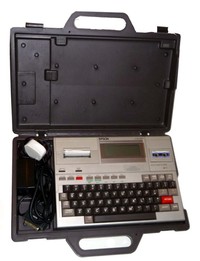Epson HX-20 with Hard Case
| Home > Browse Our Collection > Computers > Epson > Epson HX-20 with Hard Case |
|
The Epson HX-20 (also known as the HC-20 in Japan) is regarded by some as the first laptop computer. It was invented in 1980 by Yukio Yokozawa, who worked for Suwa Seikosha, a branch of Japanese company Seiko (now Seiko Epson), receiving a patent for the invention. In 1981 it was announced as the HC-20 in Japan, and the HX-20 at the COMDEX computer show in Las Vegas, and went on sale in Japan and worldwide the following year. A lack of software and distribution meant it was not sold widely until 1983. It was hailed by BusinessWeek magazine as the "fourth revolution in personal computing". The HX-20 was advertised as the "world's first 'note-book size' portable computer"; despite being the same size as an A4 sheet of paper and weighing 4lb [1.8kg], the computer housed a full-size keyboard, built-in display and printer. It was priced at under £500, and aimed at the business user. The LCD screen provided 20-character by 4-line display with a 120 x 32 dot graphics resolution. The built-in inked-ribbon matrix printer prints graphics and upper- and lower-case characters. The space to the right of the screen can be occupied by either a microcassette drive for program or data storage, or a plug-in ROM cartridge. The built-in NiCad batteries had a battery life of about 50 hours before they needed to be recharged. The system came with 16K RAM, which can be expanded to 32K, and 32K ROM containing Microsoft Basic and the operating system. The HX-20 uses two 6301 processor chips from Hitachi, one to look after all I/O and housekeeping tasks, and the other for language processing. The computer was also equipped with a date and time clock, audio cassette interface, built-in speaker, RS-232C port, high speed serial interface and a barcode reader port for greater versatility in special applications. An external acoustic coupler, the CX-20, was available for the HX-20, as was an external floppy disk drive, the TF-20, and an external speech synthesis Augmentative Communication Device (ACD), ‘RealVoice’. Another extension was the serially connected 40 x 24 character video. It used a special protocol, EPSP, which was also used by the external floppy disk drive. The battery life of the HX-20 was approximately 50 hours running BASIC and less using the microcassette, printer or RS-232. Manufacturer: Epson Comment on This Page Magazines RELATED to Epson HX-20 with Hard Case in our Library
Other Systems Related To Epson HX-20 with Hard Case:
This exhibit has a reference ID of CH16828. Please quote this reference ID in any communication with the Centre for Computing History. |
Click on the Image(s) For Detail
|











